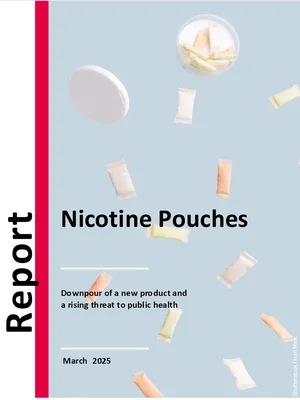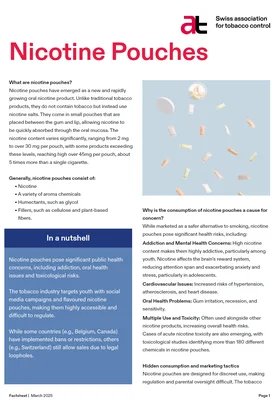Nicotine Pouches
Key Facts
|

What are nicotine pouches?
Nicotine pouches have emerged as a new and rapidly growing oral nicotine product. Unlike traditional tobacco products, they do not contain tobacco but instead use nicotine salts. They come in small pouches that are placed between the gum and lip, allowing nicotine to be quickly absorbed through the oral mucosa. The nicotine content varies significantly, ranging from 2 mg to over 30 mg per pouch, with some products exceeding these levels, reaching high over 45mg per pouch, about 5 times more than a single cigarette.
Generally, nicotine pouches consist of:
- Nicotine
- A variety of aroma chemicals
- Humectants, such as glycol
- Fillers, such as cellulose and plant-based fibers.
Why is the consumption of nicotine pouches a cause for concern?
While marketed as a safer alternative to smoking, nicotine pouches pose significant health risks, including:
Addiction and Mental Health Concerns: High nicotine content makes them highly addictive, particularly among youth. Nicotine affects the brain’s reward system, reducing attention span and exacerbating anxiety and stress, particularly in adolescents.
Cardiovascular Issues: Increased risks of hypertension, atherosclerosis, and heart disease.
Oral Health Problems: Gum irritation, recession, and sensitivity.
Multiple Use and Toxicity: Often used alongside other nicotine products, increasing overall health risks. Cases of acute nicotine toxicity are also emerging, with toxicological studies identifying more than 180 different chemicals in nicotine pouches.

Hidden consumption and marketing tactics
Nicotine pouches are designed for discreet use, making regulation and parental oversight difficult. The tobacco industry employs aggressive marketing, especially through social media, targeting young consumers with attractive flavours (e.g., berry, cinnamon, peppermint). Campaigns often use misleading claims associating nicotine pouches with relaxation and social success.
ZYN, a leading brand, saw U.S. sales surge to 443 million boxes annually by early 2024. Studies show that social media advertising plays a critical role in their rising popularity, similar to past cigarette marketing strategies.
Regulatory examples
Belgium: Banned nicotine pouches from October 2023 due to addiction and health concerns.
Norway: Requires pre-approval for new nicotine products, with no nicotine pouches currently authorized.
Switzerland: Nicotine pouches are freely available, and widely sold.

Conclusion
Nicotine pouches are expanding rapidly, driven by industry marketing and regulatory loopholes. While some countries have begun restricting sales, the lack of widespread regulation poses a growing public health challenge. Stricter policies and public awareness campaigns are necessary to curb youth uptake and mitigate health risks.

